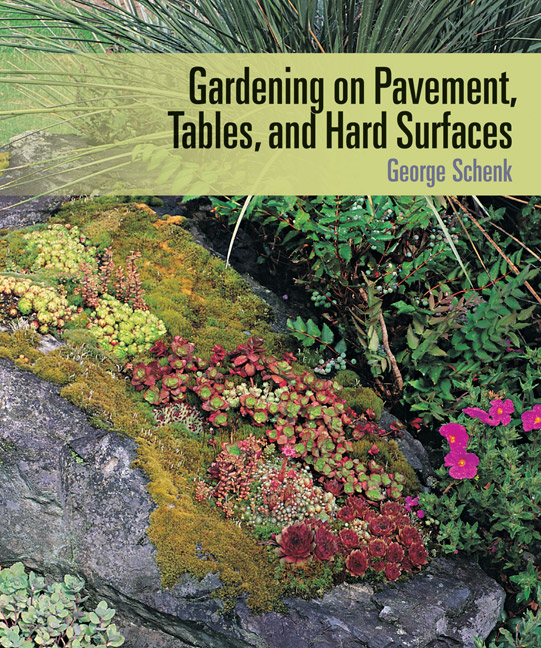Gardening on Pavement, Tables, and Hard Surfaces, George Schenk, Timber Press, Portland, OR (2003); 192 pp, softcover; publisher's price: $19.95; Amazon price: from $80.79.
This book deserves to be read by any experimental or adventurous gardener. Although peripherally related to trough gardening, or any form of container gardening for that matter, a very important difference hits one with full force almost right away: George Schenk has done away with the containers! He arranges his small-scale landscapes on stone and brick "railings" — on stumps and on logs, sometimes even upside-down logs — to great effect. He uses parking-pad paving as a prime piece of gardening real estate and employs rocks and many forms, sizes and styles of tabletops to create his magical gardens.
There is a precedence for at least one form of this called slab gardening. Effective and charming, it mostly uses rock garden plants as subjects. Schenk's sense of play moves him to expand that vocabulary to include succulents, annuals, perennials, ferns, trees...if it inspires him, he uses it! There is a chapter on planting between pavers plus descriptions of meadows and gardens on rooftops and unused bridges. He offers helpful how-to information along the way.
This book is great fun but I would be remiss if I did not mention a potentially big problem for gardeners in many parts of the U.S., including here in the Northeast. Mr. Schenk splits his gardening time between Vancouver, Auckland and Manila and he draws his experience from gardens sited many zones warmer than ours. His plant lists, in my opinion, have overly optimistic zone assignations: Hebes and Lithodora pop immediately into mind.
Also, it would behoove the reader to plumb the text and not just the photo captions when deciding to embark on one of his projects. Even in Vancouver he lifts the miniature trees that he has growing on picturesque rocks and heels them into sawdust for the winter, a fact not noted under the pictures. Be aware, too, that this type of gardening by its very nature uses a much shallower depth of soil, which instantly lessens a plant's hardiness. Add to that the fact that many of his creations are raised substantially up off the ground and you can see the need to choose plant material at least a couple of zones hardier than usual to ensure success.
For all that, I find the book fresh, inventive, eminently readable, funny and engaging. Schenk's voice and turn of phrase is like no one else's. When writing about using driftwood for retaining soil he says: "For maximum stability, the pieces of wood should be about as big as dolphins and dalmatians." We instantly get his point, and I, for one, will never forget this image.
Reprinted from the Oliver Nursery Newsletter, with permission from the author.

